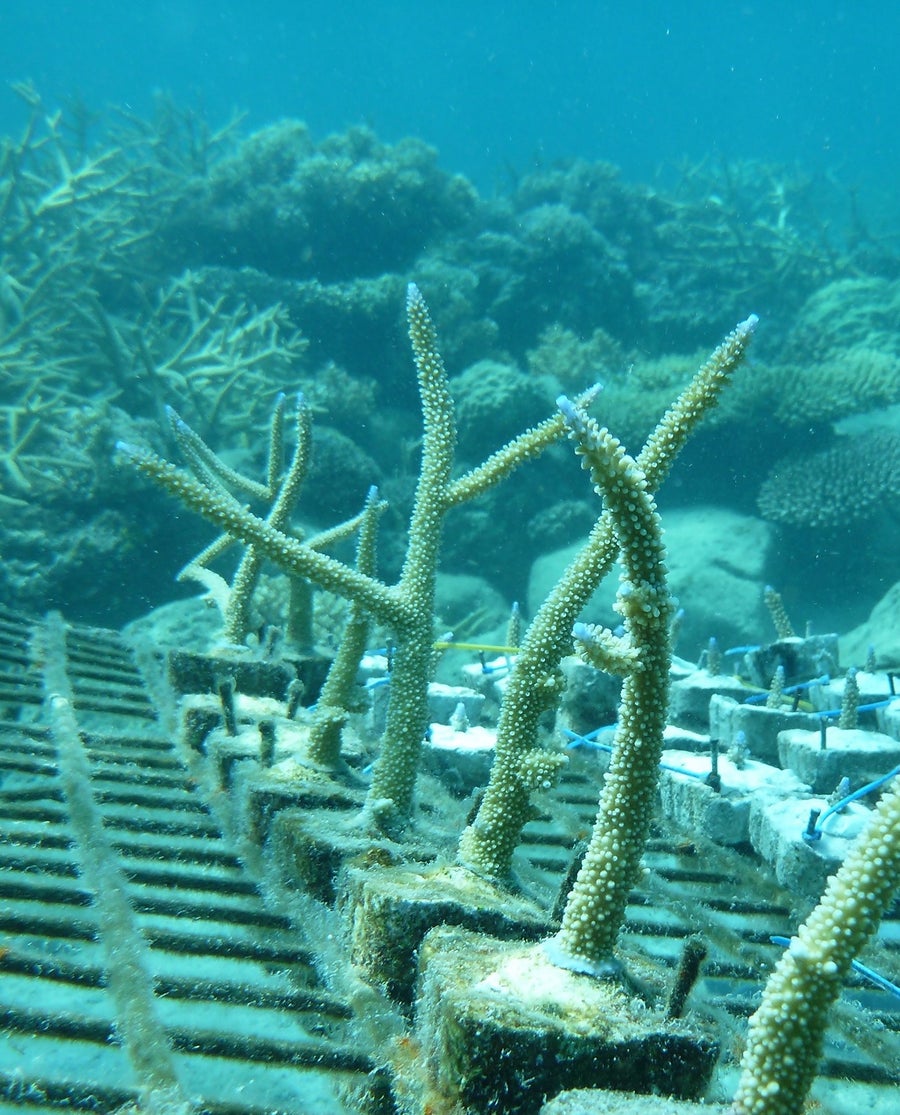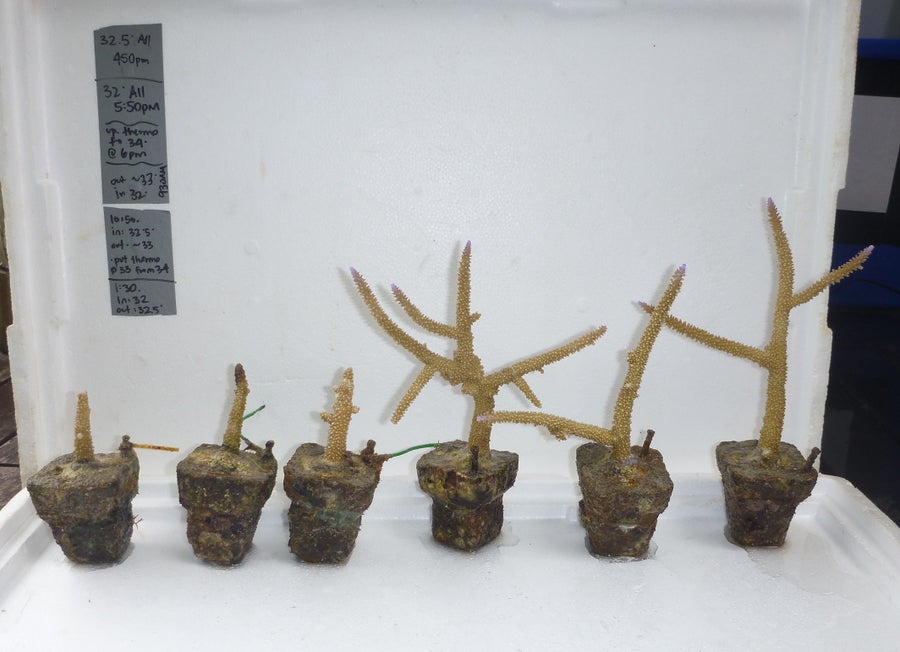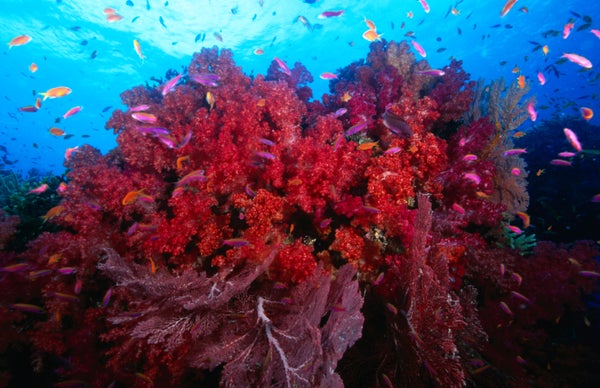When marine biologist Candida Savage was collecting samples of nitrogen and other nutrients in the coastal waters of Fiji, she was jarred by what she found at one horseshoe-shaped coral reef: The nitrogen levels were off the charts. It was the last thing she had expected to find in a pristine environment brimming with healthy corals and diverse fish, far from the farming activities and polluted wastewater that typically accompany high nitrogen levels.
“At first I thought we had mislabeled the samples, because the nutrient levels were far higher than the other areas in Fiji that were more heavily impacted by human activities,” says Savage, who is based at the University of Otago in New Zealand. Scrambling for an answer, Savage hit upon the nitrogen-rich feces produced by a large colony of seabirds nesting on forest-covered Namena, the island encircled by the reef.

Coral fragments one year after they were transplanted to the Namena reef. Credit: Candida Savage
On supporting science journalism
If you're enjoying this article, consider supporting our award-winning journalism by subscribing. By purchasing a subscription you are helping to ensure the future of impactful stories about the discoveries and ideas shaping our world today.
Seabird excrement, or guano, is known to have a fertilizer effect in tropical marine ecosystems; it boosts the numbers of tiny phytoplankton at the base of the food web and enhances fish growth. In contrast to nitrogen sources like fertilizer runoff, guano contains a balanced ratio of nitrogen, phosphorous and traces of other elements important for growth, such as iron. While it was known that corals absorb these guano-derived nutrients, Savage wanted to explore whether an abundance of them actually makes corals grow faster.
To find out, Savage returned to the Namena reef to investigate whether seabird guano accelerated the growth of staghorn corals, known for their spindly, branching skeletons. She compared Namena specimens’ growth rates to those of staghorn corals about 15 miles north in a protected no-fishing area near Fiji’s second-largest island, Vanua Levu. Environmental conditions are similar at both sites—with no signicant differences between light levels, temperatures or wave energy—but Vanua Levu has relatively few seabirds.
Savage collected 36 coral fragments from healthy staghorn colonies in Namena and Vanua Levu, then transplanted half of the ones from Namena to Vanua Levu, and vice versa. For comparison, Savage transplanted the remaining fragments within the sites from which they originated. When she returned the following year, she found the corals that had been relocated to the guano-enriched waters around Namena had grown an average of 15 centimeters—about four times faster than those transplated to Vanua Levu. The specimens at Namena also contained higher quantities of the symbiotic algae that feed corals, compared to those without guano enrichment. Although Savage had expected to see a slight difference between the two sites, she says she was “surprised by the magnitude of the effect.”

Coral fragments grown near seabird roosting sites (the three to the right) had growth rates up to four times faster than corals grown without the influence of seabird nutrients (the three to the left). Credit: Candida Savage
The findings, published in Scientific Reports in March, point to the need to better understand how land and marine ecosystems interact; doing so could help managers determine which coral reefs will respond well to restoration and preservation efforts, Savage says. For instance, reef systems located near seabird colonies may be more robust than those in nutrient-poor waters. The study also suggests the need to incorporate the conservation of seabirds—more than a quarter of which are believed to face some risk of extinction—into coral reef management. “We need to consider how nearby land habitats can benefit the marine environment, instead of seeing them as separate systems,” Savage says.
David Suggett, a marine biologist at the University of Technology Sydney, says the findings are an important step in understanding how land and sea are connected. But he cautions that the nutrient boost provided by guano could have some negative consequences for corals under stress. “It’s important that these results are not read as ‘nutrients are good’ for the reef. They can be, but in moderation,” says Suggett, who was not involved in Savage’s research. “While enhanced nitrogen and phosphorous may help reefs recover from disturbances, this fast growth can leave some corals more susceptible to bleaching,” which occurs when the beneficial algae are expelled from coral tissue, leaving just the white skeleton behind.
Savage plans to explore how seabird nutrients affect various coral health indicators, such as resilience to bleaching or physical damage. This information could lead to clearer insights into how the additional nutrients in guano could help corals rebound after extreme events like Cyclone Winston, which battered Fiji in 2016 after Savage conducted fieldwork for the study. “The storm caused a lot of damage to the forest on Namena, and possibly to the seabird colonies that nest there,” she says. “It would be interesting to do a follow-up study to see whether the nutrient levels have changed, and how the reef is faring as a result.”
